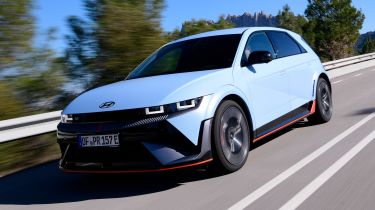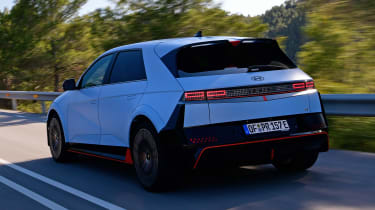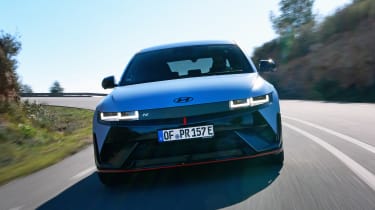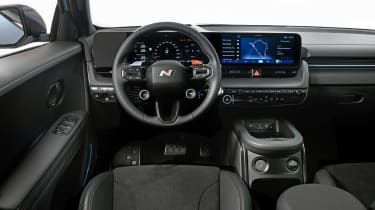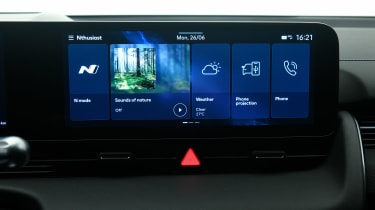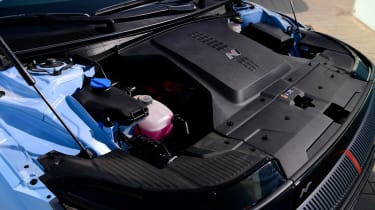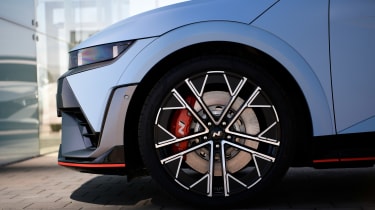Hyundai Ioniq 5 N review: an electric hot hatch that defies the doubters
Hyundai has engineered the Ioniq 5 N to provide smiles for miles thanks to its blistering performance, taut handling and plenty of gadgets and features
Pros
- Genuinely fun to drive
- Thundering performance
- Still practical
Cons
- High price
- Firm suspension
- Heavy
|
Range |
0-62mph |
Wallbox charge time (0-100%, 7.4kW) |
Rapid charge time (10-80%, 350kW) |
|
280 miles |
3.4s |
13 hours |
18 mins |
Hyundai Ioniq 5 N Verdict
Following in the footsteps of the popular combustion-powered i20 N and i30 N, the Ioniq 5 N marks the beginning of the electric era for Hyundai’s performance branch. The standard Ioniq 5 was already a strong foundation to build on, and the Korean brand’s engineers have managed to develop this rather bulky 2.2-tonne EV into one of the most convincing electric hot hatchbacks to date. It still has room for the family and it’ll return up to 280 miles on a single charge (provided your foot isn’t constantly glued to the floor), but the peak power output of 641bhp, with 770Nm of torque, means it’ll also beat some very serious machinery on track.
Details, specs and alternatives
The debate rages on about whether electric cars are genuinely fun to drive, but the Hyundai Ioniq 5’s E-GMP platform has already proven its performance credentials via the Kia EV6 GT. Kia’s most expensive car is hardly subdued (in fact it’ll happily take on a Porsche Taycan) but the Ioniq 5 N pushes this capability to a whole new level. It’s one of the strongest cases for exciting EVs that we’ve ever seen.
Electric performance cars are starting to increase in number, so the Ioniq 5 N already has some capable rivals. MG has recently entered the electric hot hatch stakes with the much cheaper MG4 XPower and, of course, there’s the Hyundai’s own sibling, Kia’s EV6 GT. On top of this, there are plenty of petrol-powered hot hatch owners who are ripe for converting, too, and they’ll need to be drawn away from models such as the Honda Civic Type R, Mercedes-AMG A45 S and the Volkswagen Golf R.
Unlike the standard Ioniq 5, there’s only a single choice when it comes to powering the Ioniq 5 N. This twin-motor setup produces a combined 601bhp and 740Nm of torque which is sent to all four wheels.
These numbers are impressive enough, but if you just need that extra bit of shove, Hyundai’s ‘N Grin Boost’ function has you covered. The name is a bit corny, but hitting the bright red ‘NGB’ button on the steering wheel will boost the power even further up to 641bhp and 770Nm.
The ‘N’ systems don’t stop there, though. Power can be juggled between the front and rear axles using the N Torque Distribution system, while the N-Pedal regenerative braking system is ideal for maintaining a steady level of charge on lengthy track sessions. Prefer to show off rather than set lap times? The N Drift Optimizer will happily oblige by helping you destroy your rear tyres in a dramatic plume of smoke.
All of this grunt is generated from an 84kWh battery pack, which is the largest ever fitted the E-GMP platform and will soon be making its way into the standard Ioniq 5. Provided you’re not hammering the living daylights out of it on the track, this pack can return up to 280 miles on the WLTP combined cycle. The Ioniq 5 N also supports 350kW rapid-charging if you can find a chargepoint that’s up to the task. This allows it to top up from 10 to 80% in as little as 18 minutes.
Along with the single powertrain, there’s also a lack of optional extras. In fact, the only add-ons are a panoramic sunroof and a selection of paint colours. Hyundai simply throws in everything else as standard and, as usual, a pair of 12.3-inch screens dominate the dashboard. Elsewhere a number of exclusive ‘N’ touches, such as bucket seats, act as constant reminders of this car’s pedigree.
Range, battery size & charging
| Range | Wallbox charging time | Rapid charge |
| 280 miles | 13 hours (0-100%, 7.4kW) | 18 mins (10-80%, 350kW) |
The Ioniq 5 N’s 84kWh battery is the largest pack ever fitted to the E-GMP platform, but it’s important to remember that high performance comes with a greater thirst for power. This means the range figure is actually lower than with the standard car’s 77kWh unit. The N can achieve 280 miles on the WLTP combined cycle, while the regular model has an official maximum of 315 miles. The new 84kWh pack will also be making its way into the regular Ioniq 5, though, so we’d expect to see the range figure grow in that car.
Thanks to the clever way that Hyundai’s engineers have packaged this larger battery, the Ioniq 5 N doesn’t sacrifice any interior space to accommodate it. The only noticeable difference is that the floor is no longer flat due to the additional charging and cooling requirements.
Just like the rest of the Ioniq 5 line-up, the N has a 350kW peak rapid charging capability. This allows it to be topped up from 10-80% in just 18 minutes, if you can find the right charger. Hyundai’s technicians claim that the Ioniq 5 N has also been designed to handle 20 minutes of track time followed by 20 minutes of rapid charging. After which it can then return for another 20 minutes of driving.
To help increase efficiency, the N’s bolder styling incorporates additional battery cooling intake vents. A heat pump is also fitted as standard.
Running costs & insurance
As with any electric car, the Ioniq 5 N will prove cheaper to run than its combustion-powered hot hatchback equivalents. However, its starting price of £65,000 is far from small change. This is over £10,000 more than the Ioniq 5 Namsan Edition, so it probably won’t be seen on the road as often.
Compared to its direct rivals, though, the N still feels like fairly reasonable value. The Ford Mustang Mach-E GT is over £2,000 more expensive than the Hyundai, while the Kia EV6 GT only undercuts it by less than £2,000. The MG4 XPower is a lot cheaper at under £37,000, but it’s also a lot less powerful.
Insurance is another area where the Ioniq 5 N will make itself known to your bank balance. Residing in insurance group 49E, it just falls short of the top group 50, so be prepared for high premiums even if you’re an experienced driver. The letter ‘E’ means the minimum security standard for this insurance group has been exceeded.
As with all electric cars, the Ioniq 5 N is exempt from VED road tax until April 2025. It will also avoid emissions-based charging such as the London Ultra Low Emission Zone (ULEZ).
Charging the Ioniq 5 N at home at an average electricity rate of 30p per kWh will cost around £25 for a full charge. Naturally, the cost of charging at a public chargepoint will vary.
Performance, motor & drive
| 0-62mph | Top speed | Driven wheels | Power |
| 3.4 seconds | 161mph | Four | 641bhp |
Plenty of electric cars boast mind-blowing performance and 0-62mph times, but there’s a strong feeling among some people that they aren’t particularly entertaining in anything other than a straight line.
The Hyundai Ioniq 5 N is by far one of the most convincing fully-electric hot hatchbacks yet. While it still offers the lightning-fast straight line performance of many other performance EVs, it also has the chassis to match.
The sole powertrain is a twin-motor, four-wheel drive setup producing 223bhp at the front and 378bhp at the rear. This combined 601bhp, along with 740Nm of torque, will propel the Ioniq 5 N from 0 to 62mph in a supercar-tackling 3.4 seconds, provided you use the launch control. It’ll then continue on to a steady 161mph.
But wait, there’s more. Hyundai’s N Grin Boost function is certainly a strangely named one (although to be fair, it’s definitely not going to make you frown) but activating it cranks up the power to 641bhp and 770Nm of torque. Top speed remains the same, but you’ll get there even faster.
That’s straight-line power taken care of, but now come all the extras that make the Ioniq 5 N truly stand out. These touches vary in size, but each one makes a positive impact on the Hyundai’s abilities. On the outside, the new bumpers have larger air intakes for cooling the battery, there’s a new rear spoiler for added downforce, and new vents in the wheel arches help to keep the brakes cool under pressure.
There’s plenty to get excited about underneath, too. The suspension is a new electronic setup that’s a lot firmer than the standard car’s. An electronic limited-slip differential has been added and the entire car has been stiffened in several areas, too.
This combination of enhancements across the board make the Ioniq 5 N a highly responsive and engaging car to drive. There are three driving modes to choose from: Eco, Normal and Sport. Choose the latter of the three and the power delivery is punchy but manageable, the steering provides plenty of feedback, there’s loads of grip from the bespoke tyres and even the body roll is kept in check on this hefty 2.2-tonne car.
When you want to slow things down, the brakes are excellent, too. Hyundai has managed to strike a balance when it comes to performance and feedback, eliminating another frequent complaint with other performance EVs. Along with the additional cooling vents, the regenerative braking system takes a lot of strain away from the mechanical components, which greatly helps towards reducing brake fade.
Perhaps the biggest party piece, and certainly the most unique one, is the N e-Shift function. Engaging this system mimics the gearshifts of an eight-speed gearbox in order to increase the level of driver engagement. Drivers can virtually change gear via paddles mounted on the steering wheel, and the N will simulate the reactions of a combustion car. The sound system also replicates either a combustion-engined car or more synthetic noises like something out of a sci-fi film. Admittedly, these sounds are quite gimmicky and could quickly prove annoying to some people, but the system as a whole is innovative and great fun to use.
Simply put, the Ioniq 5 N is a phenomenal fully-electric driver’s car that can handle itself both in a straight line and in the corners. The cherry on top, though, is that it will also settle down into a car that’s almost just as practical and easy to drive as the standard model when you just need it for everyday use. The only real downside is the much firmer ride, which could prove a bit tiresome when faced with the UK’s many potholes and speed bumps.
Interior, dashboard & infotainment
The Ioniq 5 N’s interior tech will be largely familiar to anyone who has set foot inside the standard car, and this is no bad thing. The dashboard consists of the same twin 12.3-inch screens, and the software is just as responsive to use and clear in its appearance.
There’s plenty of standard creature comforts, too, including Apple CarPlay and Android Auto, a head-up display and wireless phone charging.
It’s when you reach the steering wheel where things start to differ, though. This unique branded wheel features multiple buttons for activating the car’s various ‘N’ modes, as well as the paddles for the N e-Shift function.
The N-branded Alcantara and leather bucket seats are probably the most obvious difference over the standard car. While these are a lot more supportive when you’re driving the N as intended, they are still comfortable enough for regular everyday use.
Boot space, seating & practicality
| Length | Width | Height | Boot space (seats up) |
| 4,715mm | 1,940mm | 1,585mm | 480 litres |
There’s no mistaking that the Ioniq 5 is a big car, and the Ioniq 5 N shares this stocky stature. The upside of this is that it remains very practical for a car in this class with up to 480 litres of boot space on offer along with room for five passengers.
If you’re brave (and possibly mad) enough to want to do the school run and a track day within a few hours of each other, the Hyundai is certainly capable of doing so.
Reliability & safety rating
The Ioniq 5 N hasn’t been tested by Euro NCAP, but it shares the same safety tech as the standard Ioniq 5, which received a full five-star rating in 2021. This includes forward collision-avoidance assist and car, pedestrian and cyclist detection, along with junction turning, junction crossing, lane-changing and evasive steering assistance.
Neither the Hyundai Ioniq 5 or Ioniq 5 N have yet featured in our Driver Power customer satisfaction survey, but the brand itself finished in a middling 17th place in our best manufacturer rankings.

